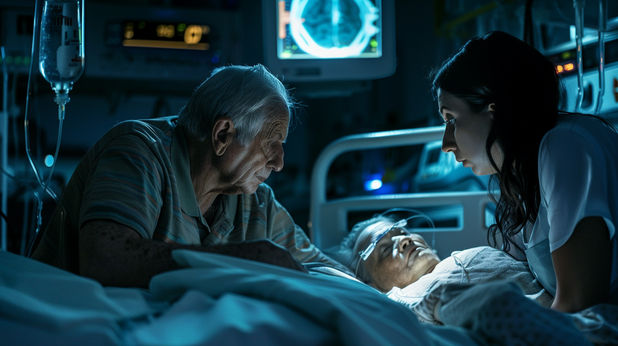I’m working on a case in Beaumont, Texas dealing with the wrongful death of a middle-aged man. He survived a car wreck and died from medical malpractice at a local hospital.
When patients arrive at the hospital after a bad car wreck, the doctors must work them up for blunt trauma injuries. The challenging part of this task is that most of the time the patient’s entire body is involved, from head to toe. To settle on one diagnosis without checking everything out is malpractice and could leave the patient in grave risk.
This is exactly what happened to this man. He was in a high-speed car wreck. When the ambulance arrived, the emergency medical technicians (EMTs) found him with multiple cuts and broken bones. This man had clearly suffered from blunt trauma injuries and was admitted to the hospital’s intensive care unit (ICU) trauma service through the emergency room.
They quickly intubated and sedated him and placed him on mechanical ventilation. The doctors were concerned about his head because of a big cut on his forehead, but a brain CT scan looked normal. Their focus over the next few days was to stabilize him.
Two days after the accident, some routine lab work started to show signs of trouble. He had a critically high lactate level, a fever, and his oxygen saturation plummeted to the 80s, even though he was on mechanical ventilation and oxygen. You typically want oxygen saturation of 95 to 100, but anything below 90 is evidence of low oxygen levels in the blood, or hypoxemia.
Fast-forward four days and his white blood cell count was two and one-half times the normal maximum. His blood pressure dropped to 90/39, even though he was on intravenous (IV) fluids and vasopressors that should’ve maintained a normal blood pressure. His oxygen saturation dropped into the 70s and he was diagnosed with Adult Registry Distress Syndrome (ARDS). It wasn’t long until he coded and died.
An autopsy was ordered. A blood sample taken from the man’s heart came back positive for Serratia marcescens.
What is a Serratia marcescens infection?
Serratia marcescens is a type of bacteria that causes a hospital-acquired infection. It’s dangerous because it can cause a serious infection that triggers a body-wide inflammatory response called sepsis. If not treated quickly and appropriately, patients can go into septic shock and die.
The main risk factors for a patient to contract a Serratia marcescens infection include hospitalization, placement of an intravenous (IV) catheter, and prior placement of instrumentation in the respiratory tract, like a breathing tube.
Of course, we know that the patient whose death I’m investigating met all of the risk factors for this type of infection. Shortly after he arrived in the hospital, providers intubated him and started multiple IV catheters for immediate access to his veins.
Differential diagnosis is a constant process
It’s up to the nursing staff to communicate to the physicians new clinical findings, abnormal vital signs, and critical lab results. The standard of care requires doctors, in turn, to consider this information and form a differential diagnosis list for all potential medical conditions or illnesses that could explain them.
The differential diagnosis process is something so basic, yet so important, that it’s taught to all physicians in medical school. The reason it’s so important is that it’s the only way to practice medicine safely. Doctors can’t settle on the first diagnosis that comes to mind without ruling out other conditions that could be dangerous and even life-threatening. Plus, it’s an ongoing process that doctors must use as additional information becomes available.
At this point in our investigation of the Beaumont case, we think that’s exactly what happened. It looks like the medical team appropriately began their treatment of this patient for blunt trauma injuries. Unfortunately, though, the nurses and physicians didn’t act on the new information right in front of them that pointed to a hospital-acquired infection and sepsis—until it was too late.
Treating sepsis and infection
Our critical care medical expert who is reviewing the case explained that when a patient has sepsis, the healthcare providers must give immediate attention to getting it under control. As that treatment is initiated, doctors can then start testing to figure out what’s causing the infection and sepsis. That can be a perforated bowel or stomach from an abdominal operation, a hospital-acquired infection, or something else.
The key take-home message is that patients are constantly changing while in the hospital. Healthcare providers need to be attentive for these changes and act on them quickly. When they don’t, there can be dire consequences, like a wrongful death caused by medical malpractice.
We are here to help
If you or a loved one has been seriously injured by hospital or medical care, then the experienced medical malpractice attorneys at Painter Law Firm, in Houston, Texas, are here to help. Click here to send us a confidential email via our “Contact Us” form or call us at 281-580-8800.
All consultations are free and, because we only represent clients on a contingency fee, you will owe us nothing unless we win your case. We handle cases in the Houston area and all over Texas. Right now we’re working on medical malpractice lawsuits in Houston, The Woodlands, Sugar Land, Conroe, Dallas, Austin, San Antonio, Corpus Christi, Beaumont, and Waco.
__________
Robert Painter is a medical malpractice attorney at Painter Law Firm PLLC, in Houston, Texas. He is a former hospital administrator who represents patients and family members in medical negligence and wrongful death lawsuits against hospitals, physicians, surgeons, anesthesiologists, and other healthcare providers. A member of the board of directors of the Houston Bar Association, he was honored, in 2018, by H Texas as one of Houston’s top lawyers. In May 2018, the Better Business Bureau recognized Painter Law Firm PLLC with its Award of Distinction.





